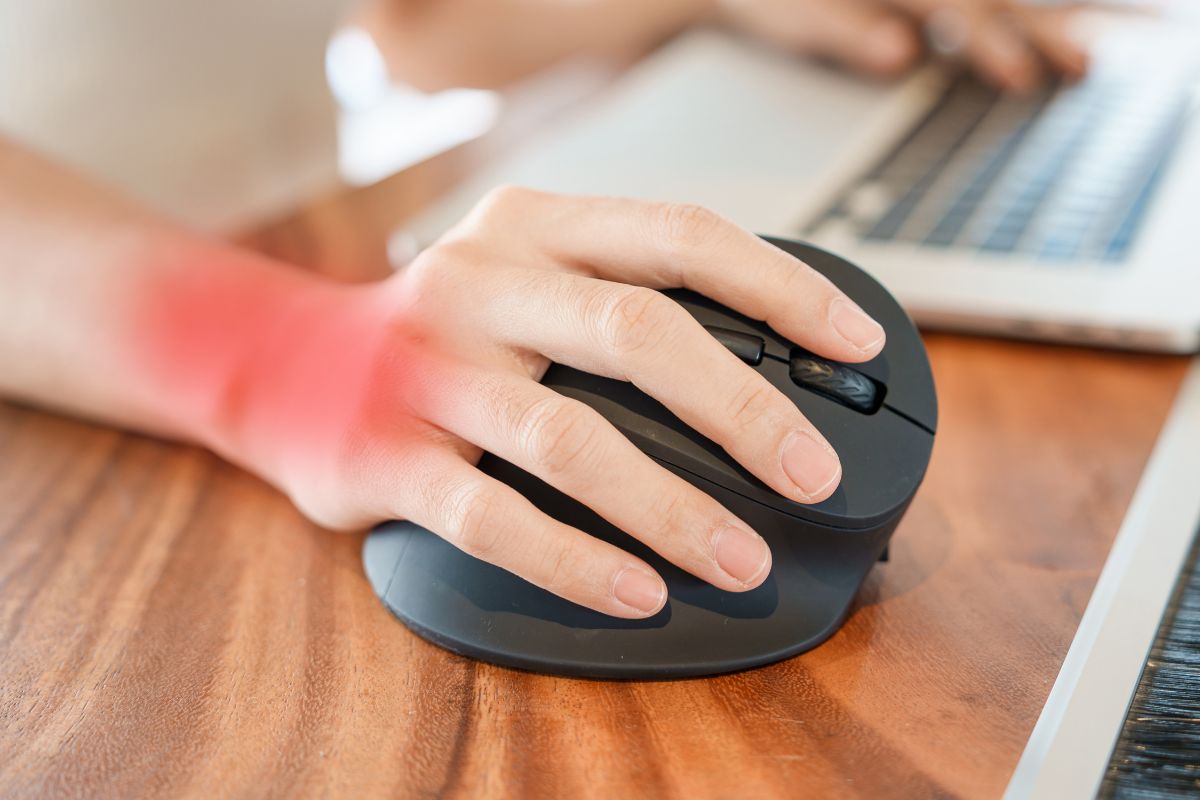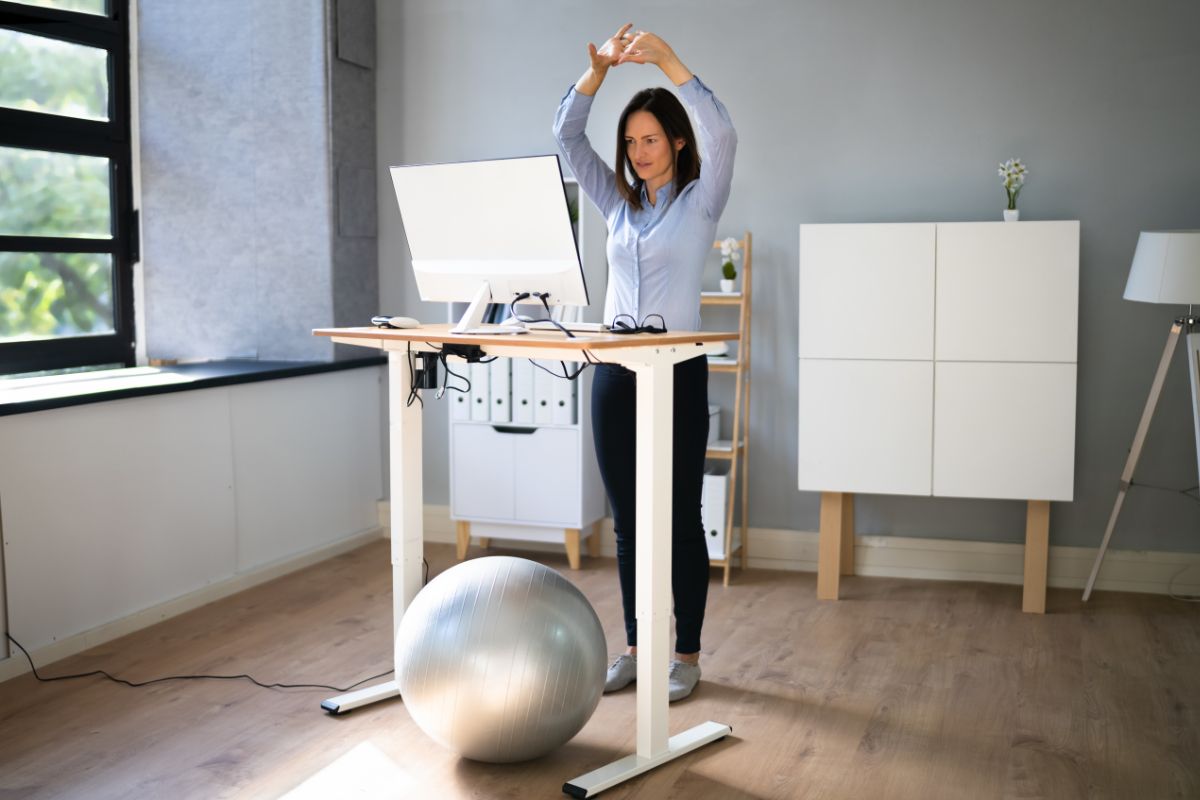Standing desks are becoming increasingly popular as we are getting more aware of how sitting for long periods of time is bad for us. If you sit at a desk all day for long periods of time, whether you're in the office or working from home, then a standing desk can be a great way to improve your health and productivity.
Unfortunately, the best standing desk is obviously of little use if it is not properly installed and adjusted. Much more so than with conventional desks, you must make sure that it is installed safely and at the appropriate height.
In this article, we will look at the different ways you can set up a standing desk, along with some tips on how to get started.
1. Set Your Standing Desk at the Appropriate Height
Firstly, you'll need to set your standing desk at the correct height for you.
When standing, the desktop should be about the height of your elbow or slightly below. Your monitor is facing you a bit (top edge tilted back about 20 degrees).
And when you look straight ahead, your eyes fall a few inches below the top edge of the screen. Ideally, your head should be tilted slightly downward! This takes the pressure off your neck and is less tiring for your eyes. The screen should also be placed at least an arm's length away from you.
 Learn more about how high a standing desk should be.
Learn more about how high a standing desk should be.2. Sit The Right Way
In order to relieve the spine and back pain, there are solutions that involve a better position of the office chair when using a stand up desk.
To do this, the spine must be supported. It should be in the same position as when walking and should not be bent. The back should be in contact with the back of the chair, from the lumbar region to the shoulder blades.
Ergonomic chairs have lumbar supports that can be adjusted very precisely according to the individual’s needs. These models also relieve stress in the lumbar region.
The position of the lower body is also very important to avoid pain. Here is how to position your legs, thighs and feet on an office chair: both thighs should be parallel to the floor; your legs should form a 90° angle with your thighs; and both feet should be placed flat on the floor.
Choosing the right chair for your desk can make a significant improvement to your health and comfort. Shop our wide range of quality ergonomic office chairs on our website, or check out our recent blog on how to choose an ergonomic chair, here.
3. Move While Using Your Desk
Don't stand for long hours like statue, move! You may think this sounds counterproductive at first, but it's exactly the opposite. Standing still is never good for your body in any position. So, after you get used to your new desk, you should move from time to time.
You can also do some calf squats or other light exercises at your standing desk. The main thing is to get your body moving and get the blood flowing. You may think that sitting too long is bad for your body, and it is, but standing too long can be just as bad. So, move around once in a while! Then you can get back to your electric standing desk (manual too) and feel energized and therefore more productive.
4. Change Your Keyboard and Mouse Positions
Your wrists may become tired from working on the computer for long periods of time. As a result, it is essential to ensure that your wrists are in the most comfortable position possible whenever you are seated or standing. When you're standing, the ideal angle should be a little bit more open (tilted upward), as opposed to when one is seated.
To protect your wrists whenever you are working in the standing position, always keep your mouse and keyboard level and your wrists straight when typing. If you still suffer from occasional wrist pain, you should think about investing in an adjustable keyboard stand and gel mouse pads so that you have the most support possible.
 An ergonomic vertical mouse is a fantastic accessory to keep your hand in a natural position.
An ergonomic vertical mouse is a fantastic accessory to keep your hand in a natural position.5. Setting up Standing-Sitting Intervals
You're probably all excited because you just bought a brand-new height adjustable desk. However, you need to start slowly, although you certainly want to succeed in changing your habits and standing as much as you can while at work.
If you do this immediately, you will be making a big mistake. If you change your natural position too quickly and maintain it for a long time, it will cause you pain and in the long run you are unlikely to continue to try and change your habits.
The trick is to make the standing breaks longer and longer over time. You should start very slowly, standing for only a few minutes, then sitting for a few minutes as well.
There is no golden rule, no set number of minutes for each break. The only rule is that you slowly and gradually increase the time you spend standing at your desk (you can start by 5, then 10, then 15, then 20, and so on). In time, you will have learned to stand for more than half an hour without feeling anything. That's the goal you should aim for.
6. Light Your Work Space Appropriately
A good ergonomic electric desk set-up needs lighting. Most of the information you receive comes from your field of vision. Darkness greatly reduces your vision, making it more difficult to perform tasks. Light allows you to focus on particular objects, such as essential documents.
One of the best height adjustable desks setups is to sit near a window. This way, you don’t only get natural light if you work during the day, but you also save energy.
You can also open your windows for fresh air, which allows you to breathe easier. The best ergonomic standing desk setup uses proper lighting so you can see better. Try to use your window as a cost-effective measure.
To avoid visual fatigue, the computer screen should ideally be perpendicular to a light source. Furthermore, the light should not be shining on the user's back to avoid reflections.
You can integrate lights or suspensions in certain areas. You can, for example, add an individual lamp to each desk if you work in an open space. Everyone can therefore turn it on at certain times of the day, depending on their needs. This allows you to improve the lighting environment so that it is always pleasing to the eye.
7. Use Ergonomic Accessories
Sit stand desk accessories are designed to help you accomplish small actions faster by reducing the time you spend on them. If you want to work with a dual monitor setup, for example, you will need a monitor arm to support the screens.
 There are many accessories you can use in conjunction with your standing desk to help you keep fit, such as a yoga ball or under desk treadmill.
There are many accessories you can use in conjunction with your standing desk to help you keep fit, such as a yoga ball or under desk treadmill.
Below is a list of some of the other items you can use, along with a brief description of their function:
- The yoga ball improves your posture, but also builds up your muscles without you even realizing it. It's fun and keeps your body moving: no more naps at the office!
- Use an anti-fatigue mat if you stand on a hard surface. An anti-fatigue standing desk floor mat supports micro-movements, which allow muscles to contract and expand. As your muscles adjust to the flexibility of your mat, they make tiny movements and try to keep you balanced. These motions improve the flow of oxygen and blood to your heart and they also help to distribute the pressure of standing evenly. Discover why you need a mat for your standing desk here.
- An ergonomic movement stool allows you to sit down and be in constant motion. This stool strengthens core muscles and improves posture, and has has a curved base that promotes movement.
- The Bloon Posture Ball allows you to sit and stay active! This is a highly ergonomic chair for any office or home – offering a way of sitting that ensures that your core is always engaged, and you are always comfortably in movement.
- A treadmill allows you to exercise while working. This is a trend that is attracting many people around the world. You can walk at the pace of your choice while doing your daily tasks. In addition to burning calories, the office treadmill will keep your mind awake! Your creativity and health will benefit in many ways.
Each of these elements is useful in conjunction with an ergonomic desktop layout.
Looking for a standing desk for your home, office or workspace? Check out our collection of standing desks, available for next working day delivery if ordered by 3pm.
Our desks come with a 7 year warranty, 30 day risk free return, as well as access to a UK-based customer service team to answer any questions that you might have.
Need additional help? Check out our top tips on using a standing desk to get the most out of your setup.
Date Published - 04/01/2023
Date Updated - 22/12/2023

